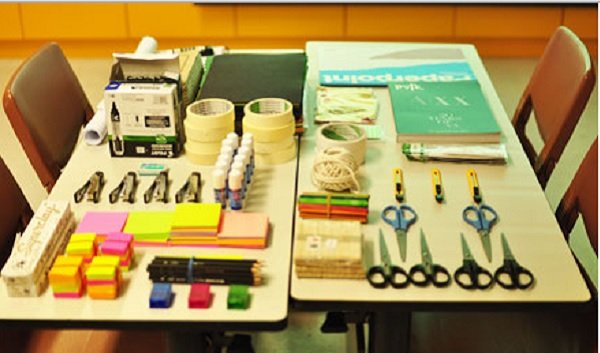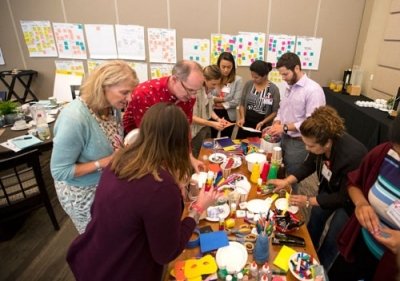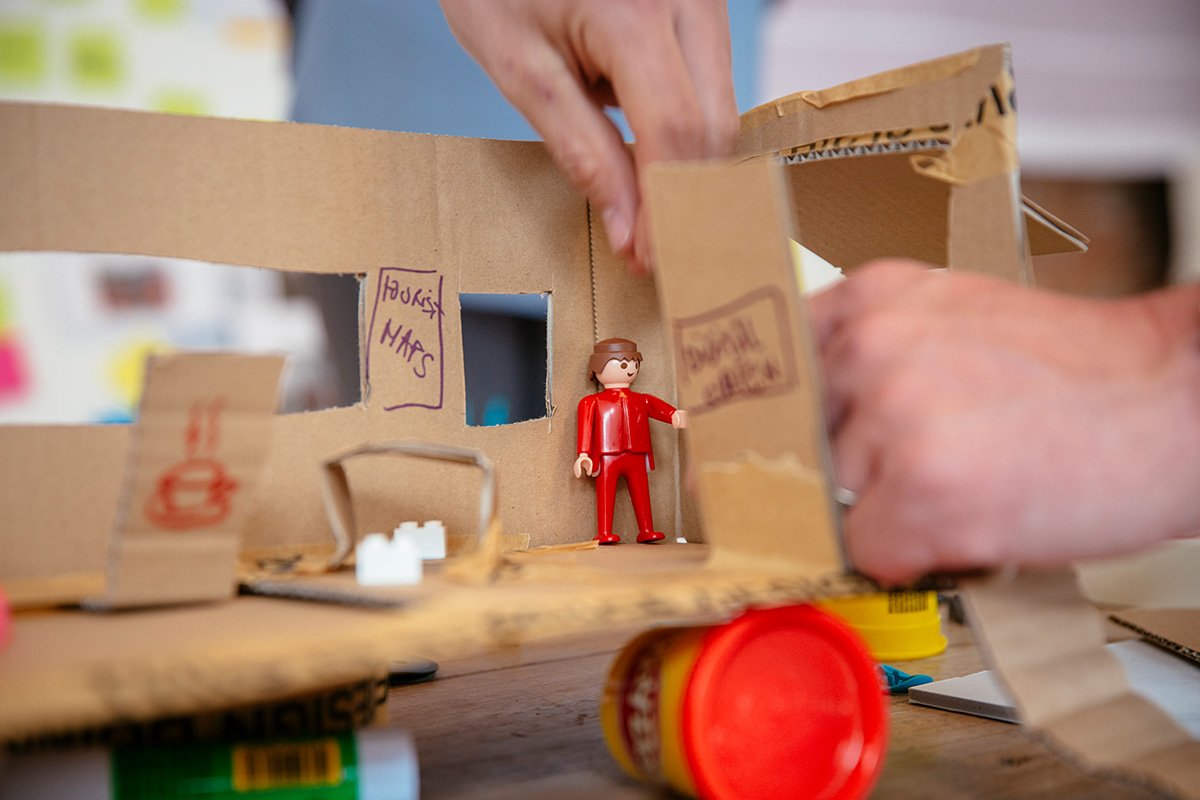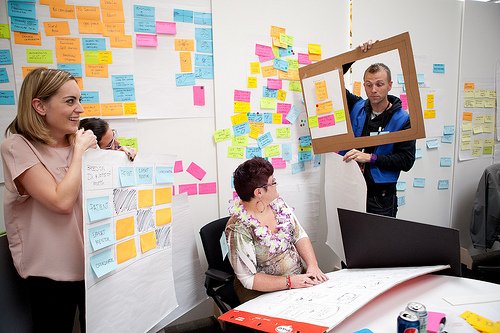What’s not wrong with Design Thinking?
It’s Tuesday. The world is falling apart. And yet someone has taken the time to write another opinion piece about all the things wrong with Design Thinking—and I mean All. The. Things!
Of course, like everyone I know, I need something to distract me at the moment—did I mention the world is falling apart? So I thought I would take a couple minutes and share my thoughts on what is not wrong with Design Thinking.
Everyone and their BBF from their favorite on-line chat group have an explanation about where Design Thinking came from, why it was designed to fail, and how it completely needs to be eradicated because it’s the one thing keeping them from being utterly fabulous!
Frankly, these people embody the reason that “designer” and “whiner” rhymes.
The myth behind the magic.
Regardless of which legend you subscribe to, the contemporary version of Design Thinking was not created to destroy design. It was not meant to replace well qualified designers with hacks. It was not a subversive plot to dumb down design. Let me tell you a secret; it was created as a business development tool for IDEO. It came about as the result of corporate leaders failing to understand design and its value—beyond making things visually pretty. It was meant to demystify design. It was meant to help design (by design I don’t mean the people, I mean the practice) be understood and valued.
Taking a step back, a couple things you need to know.
The only thing executives hate more than surprises is not being able to feel the net positive ROI for anything they are being asked to spend money on.
Up to the point where IDEO introduced their version of Design Thinking, the design profession had done a pretty poor job of expressing its value in clear business terms.
Designers were very happy to operate as a black box: Requirements go in, get rejected/redefined/rescoped, and design comes out. You’re welcome.
When IDEO rolled out their version, design was hot. Steve was back at Apple, it was the post internet bubble boom, and design was everyone’s favorite cover story.
Enter IDEO’s Design Thinking.
David Kelly is famous for saying “Look around you, everything you see except nature was designed by someone”. He and his colleagues at IDEO realized that same holds true for processes, in this case a business development process. By 2004, design was in high demand; everyone wanted it, people were scrambling to get design, but corporate leaders did not really knew what it took to produce great design.
IDEO had been pushing for years to get design into the mainstream (their ABC Nightline Shopping Cart Deep Dive aired in 1999!) But IDEO—along with other every other design firm, team and professional, was tired of the sticker shock that came in response to their design proposals. So the folks at IDEO came up with the idea of offering their budget conscious clients an alternative: they would teach them IDEO’s “secret” method. And thus, the Design Thinking Workshop was created.
When a client would balk at the cost of a proposal, IDEO would sell them a one-week workshop: For $30-$60k, or so the pitch went, you and 20 of your colleagues can learn the secrets of Design Thinking! Clients would send their team to Palo Alto to spend a week with IDEO. There, immersed in the adult playground that was IDEO, these folks could give themselves permission to be creative again. The week included presentations, round-tables, and warm-up exercises. And of course a hands-on design workshop.
For these workshops they would break out into teams of 4-5 people, each of these smaller team would be assigned an IDEO “coach”. While the projects varied, one of the more common projects was redesigning the ticket buying experience at the CalTrain station there in in Palo Alto. Armed with Polaroid cameras and little notebooks, these client teams would go observe people trying to buy a ticket. Of course, deeply observing any mundane task, you quickly appreciate how awkward and challenging it can be when you include things like children, dogs, shopping bags, luggage, etc. It’s also a guaranteed way to understand your biases and to learn your assumptions don’t reflect the reality.
(This also happens to be the first thing designers get push back on when they are proposing running design research at the beginning of a project: “We know what they need, just design it.” )
Back at IDEO these groups would reflect on their observations. Once clients’ teams synthesized the team’s observations, they discovered the real problem to be solved and they would reframe the problem based on what they saw rather than based on their assumptions. (Imagine!)
(This is commonly the second area of push back designers face—realigning the project around the systemic problem(s) faced by customers not a set of internally driven assumptions.)
Once these teams understood the real problem, they would enter the most intimidating part of the workshop; ideation. This is where the IDEO coach would often play a larger role helping people express their ideas. Getting everyone to be an active participant in shaping a solution, building on each other’s ideas, and thinking outside the box as it were And experiencing first-hand the value of trans-disciplinary points of view.
(If I didn’t know better there seems to be a pattern here… participation in ideation is another common complaint from design teams. Either not being included, or not being able to get other disciplines to participate.)
Before these teams were really done ideating, their coach would encourage them to begin making.
The tools these teams were given were very simple, quite primitive in many ways; cardboard, tape, sticky notes, construction paper, glue, Legos, Play-doh, pipe cleaners, markers—all the things that make kindergarten fun but definitely not the tools used by professional designers.
Again underscoring that the goal of the workshop was not to teach anyone how to design, it was to help them understand the value of design.
With their designs still a work in progress, each group was then asked to explain their design, walk everyone their prototype and connect it back to what they had observed. Reinforcing that the human/user/customer needs to be in the driver’s seat. Imagine that.
(Using rough, incomplete prototypes (sketches) to explore & evaluate ideas is foundational to design. But can be a double edged knife when a colleagues sees these as final rather than works in progress. Having non-design colleague who can recognize when an idea is just idea seems like a good thing.)
It is clear, goal of these workshop was never to create the final design, or even to teach people how to design. The goal was to help non-designers understand why designers do what they do, why design research is important, how designers generate and explore ideas, and to give these non-designers the confidence to engage with designers. In the end the people participating in these workshops were excited about their experiences, and what they created. They had learned to make with their hands, that they could explain ideas without PowerPoint. They felt like they understood and valued the design process and that they could engage with designers as peers.
But—and this is the most important part, the critical thing that all these people complaining about Design Thinking need to learn: Every one of these clients learned there was no fucking way they were ever going to design something that looked like it was created by a PROFESSIONAL DESIGNER!!!
Don’t believe me?
Based on a private conversation I had with David Kelly, that I later corroborated with multiple people at IDEO responsible for business development, nearly 90% of the companies that went through one of their Design Thinking Workshop immediately signed on the dotted line.
So not only did these company leaders come out of the workshop better prepared to engage with design, armed with an appreciation of what design can deliver they were also primed to spend some real money on design.
At the time I also had access to the innovation leadership from dozens of large multinational companies who had in fact done just that. These were companies that had initially declined IDEO’s proposal due to its cost but after going through their Design Thinking Workshop, they were eager to sign on as a client with IDEO.
And it didn’t stop there… One of the people I spoke with was the Global Head of Supply Chain for a well-known, international food company. After experiencing the impact of IDEO and design firsthand, not only did this individual contract for additional projects with IDEO, he also sent multiple teams from his organization to Palo Alto to go through the workshop. And he also set aside money from his own budget to pay for 20 teams from other divisions of the company to do the same. Let that sink in a minute. Here is a guy running a massive global organization, paying the bill for approximately 400 people from other parts of the company to participate in a Design Thinking Workshop!
IDEO not only designed an awesome business development process, that taught their clients the value of design, that process also converted those same clients into doing business development for IDEO!
So still believe Design Thinking is the problem?
To me it’s clear, it is in fact has been and can continue to be a great opportunity, regardless of the insecurities and imposter syndrome prevalent within some members of the design profession. The only challenge with Design Thinking that I can see is that many organizations have decoupled it from the Workshop—which as we have seen, is a great way for non-designers learn the real value of design. Making it far easier for designers to get the time/budget they need to do research, develop prototypes, and validate ideas & solutions with customers.
Design Thinking has the potential to build inclusion, understanding, and to give colleagues from other disciplines the creative confidence to participate and more importantly to understand the why & how behind design. But they need to have the chance to learn it in a safe environment, away from their day to day responsibilities, so they can give themselves the permission to be creative again.
Epiloge
One thing I didn't mention when I originally wrote this post; When I was at SAP we took that quote about “everything around you was designed by someone” to heart. We weren’t designing SAP’s user experiences, we were designing:
Company Policies
HR programs
Vendor Contracts
Business strategies
Technical Architectures, schemas & object models
Software Development Lifecycles
GTM plans & Marketing/Sales Programs
Tiered Consulting programs
Business Ecosystems
etc.
While I would never assume to write a contract between two multi-billion corporations, my team work with our lawyers to understand how they could take a new perspective to contracts and design an agreement that would save our company millions and make our vendors happier. Going beyond the Legal Department we did the same with HR, Business Development, Engineering, Consulting, etc. We worked with each of these teams to improve how they were designing their strategies, programs, and deliverables. I believe one of the main reasons we were able do all of that was because there were no walled gardens, complex jargon, proprietary tools, egos, or territorialism; we intentionally kept the process accessible, open-sourced, and inclusive.
In the end capital D-designers can't keep other people or professions from designing but we can share our knowledge and our approach to problem solving to help them learn how to design better.






